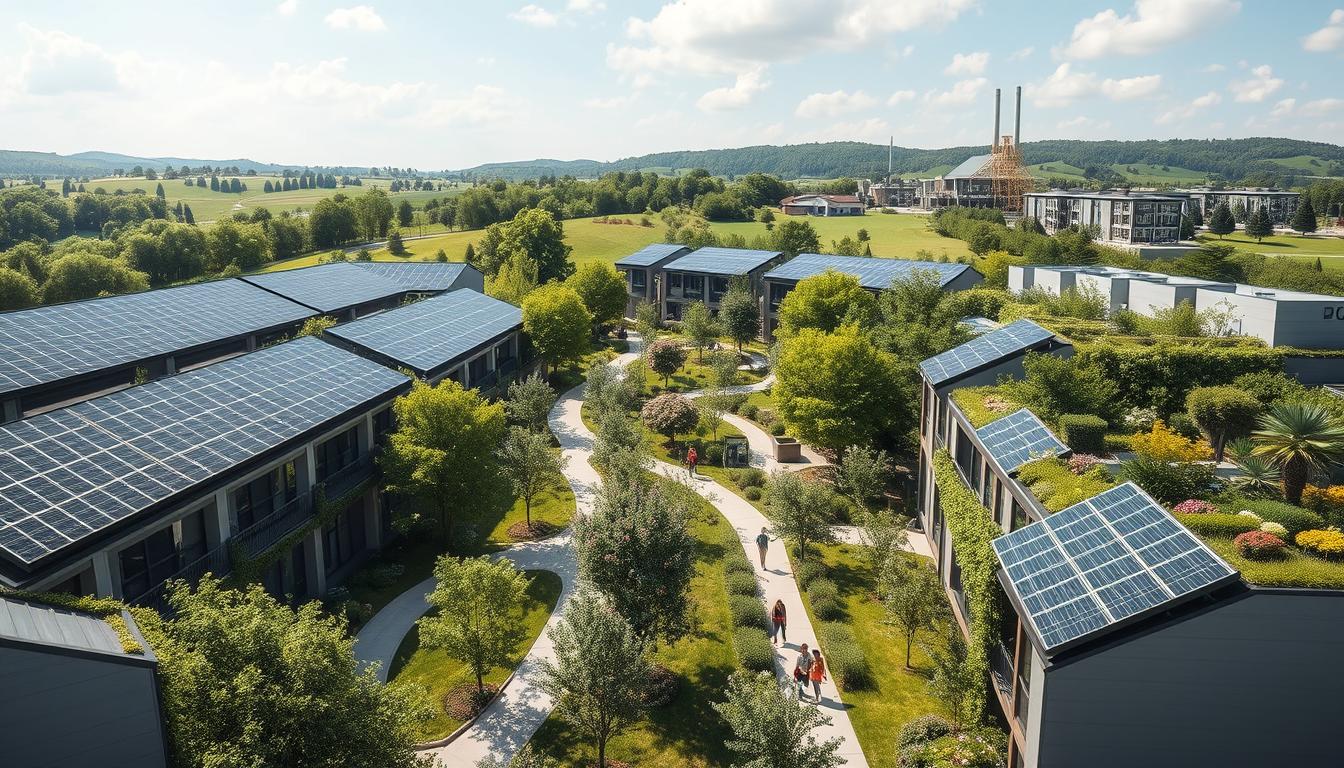The real estate industry is witnessing a monumental shift towards sustainability. This change is fueled by the pressing demand for sustainable development and climate-friendly housing. Net zero real estate has transformed from a trendy term to an essential objective. The quest for net zero is paramount as the building and construction sectors are key contributors to global energy-related CO2 emissions, accounting for approximately 39%.
Internationally, reducing carbon emissions has made net zero a top priority in real estate. Developers, investors, and policy makers are embracing innovative and sustainable practices more than ever. This shift is supported by evolving regulations, including new codes and standards that require green building practices and energy-efficient properties.
The rising interest among investors in sustainable assets and the notable advantages of green buildings are driving this trend forward. These benefits include reduced operational costs and improved well-being for occupants. The real estate sector’s future is unmistakably oriented towards sustainability, highlighting the importance for industry professionals to adapt.
Key Takeaways
- Net zero real estate addresses the high carbon emissions from buildings and construction.
- Sustainable development and climate-friendly housing are becoming industry norms.
- Regulatory changes are driving the adoption of green building practices.
- Investors are increasingly demanding sustainable assets.
- Green buildings offer substantial environmental, economic, and social benefits.
What is decarbonization and why it matters in real estate
Decarbonization in the real estate sector means reducing carbon dioxide emissions from buildings’ construction and use. It tackles climate change head-on, making decarbonization in real estate crucial. The industry uses a lot of energy for heating, cooling, and lighting. It also consumes vast amounts of construction materials.
By reducing these emissions, the impact on the environment is minimized. This effort brings several business benefits as well.
Making strides towards green buildings enhances their market appeal and long-term profitability. Eco-friendly homes see lower operating expenses and an increase in asset value. This is due to investing in energy-efficient solutions, sustainable materials, and renewable energy sources.
| Benefit | Explanation |
|---|---|
| Marketability | Green buildings appeal to a growing segment of eco-conscious consumers |
| Cost Reduction | Energy-efficient buildings lower utility bills and maintenance expenses |
| Increased Asset Value | Eco-friendly homes have higher resale values and demand |
The impact of net zero targets on value and operations
Net zero initiatives are transforming the real estate landscape. They make properties more valuable and efficient. Investing in energy-saving technologies and renewable energy can be expensive. However, these investments pay off by decreasing energy bills and maintenance costs over time.
Eco-friendly buildings are becoming more desirable. They often have higher market values. This is because they appeal to tenants and buyers who value sustainability. As a result, properties with green features gain a competitive advantage.
Meeting net zero goals means constantly enhancing energy efficiency. This ongoing effort keeps operations lean and sustainable. It also aligns with evolving environmental objectives. Moreover, as carbon emission regulations tighten, property managers are propelled toward net zero commitments. This ensures compliance in an increasingly eco-conscious industry.
| Aspect | Traditional Buildings | Net Zero Buildings |
|---|---|---|
| Market Value | Standard | Higher due to sustainability |
| Operational Costs | Higher energy expenses | Lower due to efficiency |
| Tenant Attraction | Standard | Higher due to eco-friendly features |
| Regulatory Compliance | Minimal | Advanced, meeting green regulations |
Embracing net zero is both a strategic choice for better value and efficiency, and a necessary step for a sustainable real estate industry.
Effective decarbonization strategies: from quick wins to long-term plans
In the realm of real estate, effective decarbonization strategies are divided into two types: quick wins and long-term plans. Each has distinct benefits, contributing to the overarching goal of net zero emissions. Through simple changes like switching to LED lighting and improving insulation, immediate improvement is noticeable. These quick wins boost a property’s energy efficiency and set the stage for lasting sustainability.
For a deeper, lasting impact, adopting long-term strategies is crucial. This might involve retrofitting older buildings with modern energy systems or making sure new constructions meet high green building standards. These steps help in creating energy-efficient properties, pushing us closer to the goal of sustainable real estate powered by renewable energy.
Employing a phased approach to decarbonization proves beneficial for real estate assets. It strikes a balance between the initial expenses and the steady progression towards improved sustainability. By strategically planning and executing these strategies, property owners and developers can significantly lessen their carbon footprints. Simultaneously, they enhance the value and attractiveness of their properties.
Common pitfalls in real estate sustainability efforts
The push for net zero real estate is robust, but various obstacles can derail these ambitions. One major hurdle is the underestimation of the significant initial investment for energy-efficient changes. It’s crucial to plan properly and allocate enough resources for sustainable growth in this field.
The tendency to lean heavily on carbon offsets rather than executing actual reductions is another issue. Authentic eco-friendly properties demand substantial alterations in how energy is used and waste managed. Missing these transformations keeps the goal of net zero just out of reach.
Another stumbling block is the scarcity of comprehensive data. Lack of solid information can lead to suboptimal choices, hindering sustainable progress. It’s imperative to invest in systems that offer detailed, precise data to guide strategic sustainable actions.
Moreover, not involving stakeholders, including tenants and the surrounding community, can obstruct and slow down sustainability initiatives. A unified approach, incorporating all parties, is key to developing lasting eco-friendly residences.
To tackle these issues, a strategic method covering all aspects of property handling, investment, and redevelopment is necessary. Real estate can only move towards true sustainability by acknowledging and addressing these common setbacks.
Looking ahead: net zero as a positioning and partnership opportunity
The drive towards net zero opens significant opportunities in the real estate world. Regulatory shifts and changing consumer preferences are turning the spotlight on energy-efficient properties. Those adept at delivering such properties stand to gain a strategic edge. By emerging as pioneers in sustainability, companies can draw in eco-conscious tenants and investors, leading to enhanced property values and operating performance.
Forging partnerships is crucial for widespread decarbonization. The real estate sector must collaborate with governments, tech innovators, and environmental groups. These alliances encourage the exchange of best practices, spur technological advancements in sustainability, and help establish consistent standards crucial for the net zero goal. United efforts like these are important for forging a sustainable development path that everyone can follow.
Using accurate data and modern tools is vital for decarbonization strategies. Advanced analytics offer immediate insights into energy consumption, helping stakeholders make decisions that meet sustainability objectives. In a world leaning towards eco-friendly properties, those who tackle the net zero challenge strategically set themselves apart in a fiercely competitive marketplace.
FAQ
Why is net zero becoming a key focus in the real estate sector?
The global movement towards sustainability is highlighting the importance of reaching net zero in real estate. Buildings play a major role in our climate crisis, responsible for a significant percentage of carbon emissions. The demand for sustainable properties is rising, pushed by stricter regulations and the financial and social advantages of green buildings. This collective push makes net zero progress essential in the real estate sector.
What does decarbonization mean in the context of real estate?
In the realm of real estate, decarbonization targets reducing carbon emissions from buildings. This goal extends through construction to operation, requiring energy-efficient technologies and the use of renewable resources. By adopting these practices, the industry can fight against climate change. It also boosts property appeal, lowers running costs, and can significantly increase a property’s market value.
How do net zero targets impact property values and operations?
Net zero properties often see a surge in their market value, thanks to reduced environmental impacts and lower operational expenses. Reaching net zero status usually involves a substantial initial investment. However, this leads to savings in the long run, enhances the building’s competitiveness, and draws in tenants who prioritize sustainability. More so, meeting regulatory standards on emissions further benefits property operations.
What are some effective strategies for decarbonizing real estate?
There are immediate and long-term tactics for real estate decarbonization. Quick wins can be seen with updates to LED lighting, enhanced insulation, and smart temperature controls. More extended strategies involve renovating existing structures with advanced energy solutions and designing new buildings to meet green criteria. Taking steps towards decarbonization thoughtfully blends short-term expenses with ongoing gains in efficiency.
What common pitfalls should real estate owners avoid in sustainability efforts?
Owners often miscalculate the upfront costs of greener upgrades or lean too heavily on carbon offsets rather than actual emission reductions. A lack of solid data can hinder decision-making, while failing to involve key stakeholders can derail sustainability projects. To successfully navigate these challenges, a holistic strategy that covers all property management facets is crucial.
How can the real estate sector position itself for net zero and partnerships?
Heading towards net zero, the real estate sector can carve out a competitive edge. Embracing sustainability opens doors to attracting environmentally aware tenants and investors, enhancing property values. Moreover, partnerships with governmental and environmental entities and tech firms can accelerate progress. Together, they can drive the adoption of green innovations and solidify industry-wide standards beneficial for net zero ambitions.






